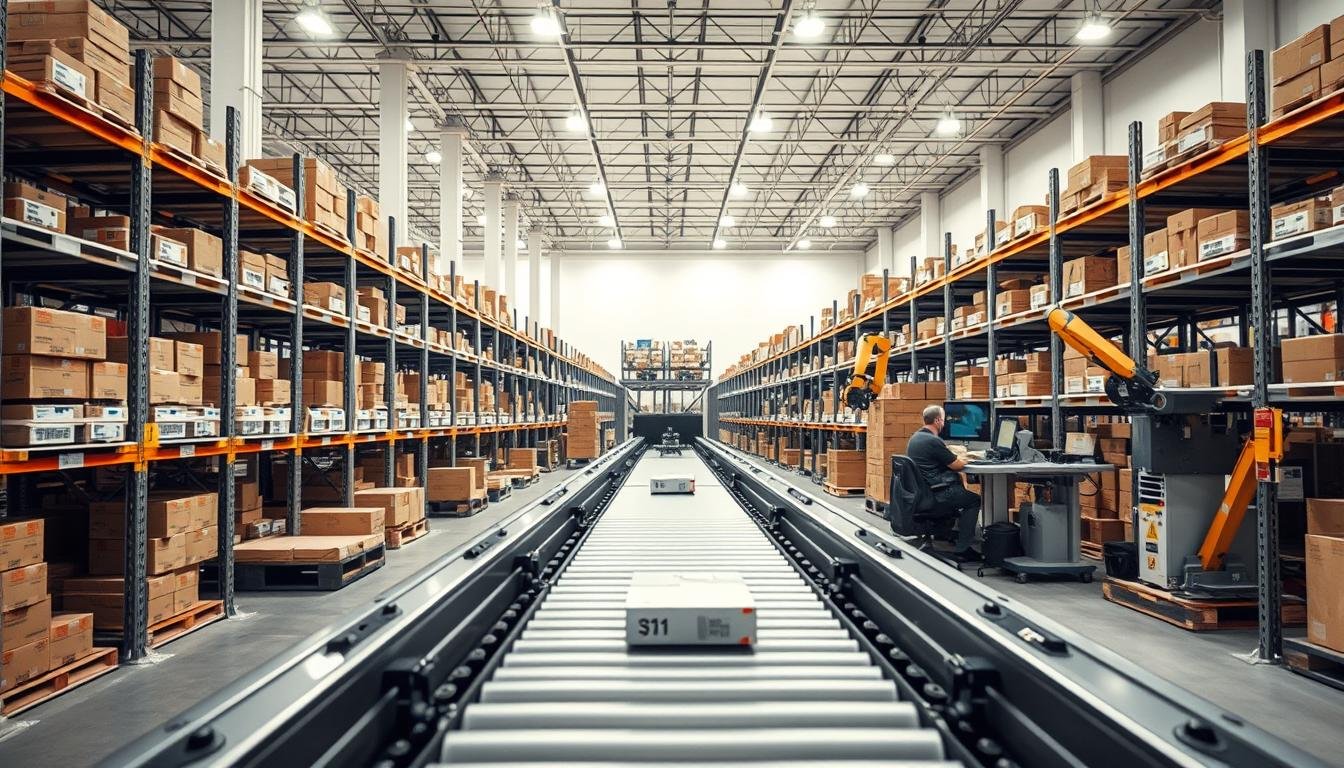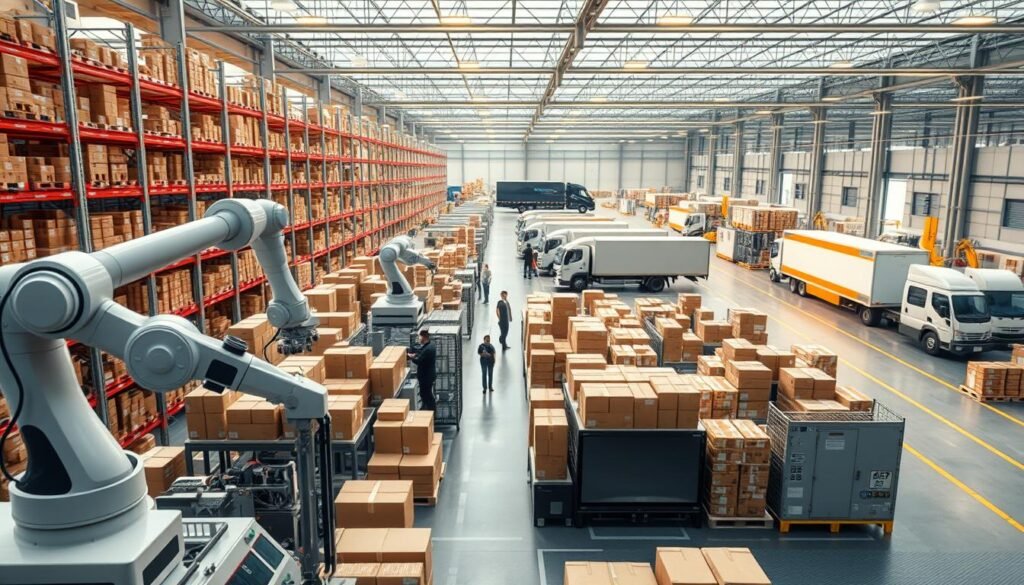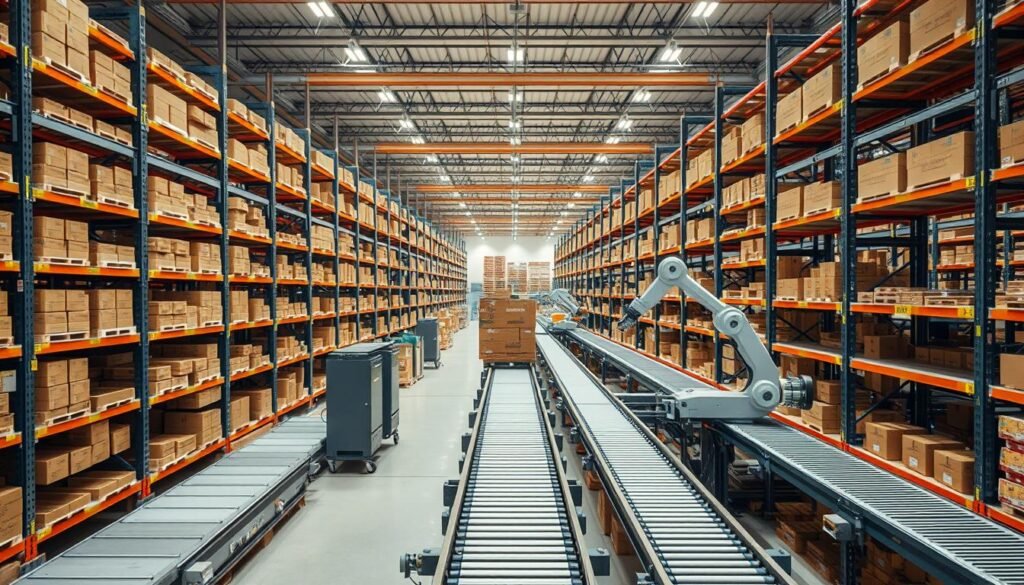Address
304 North Cardinal
St. Dorchester Center, MA 02124
Work Hours
Monday to Friday: 7AM - 7PM
Weekend: 10AM - 5PM
Address
304 North Cardinal
St. Dorchester Center, MA 02124
Work Hours
Monday to Friday: 7AM - 7PM
Weekend: 10AM - 5PM

Are you tired of manually processing orders and managing inventory for your online store? E-commerce automation can be the game-changer you need.
Streamlining your order processing and inventory management boosts your store’s efficiency and customer happiness. This lets you grow your business without getting stuck in boring tasks.
Automating your fulfillment process can change your business a lot. With e-commerce automation, you can cut down on mistakes, work more efficiently, and make customers happier.
E-commerce fulfillment automation is changing how online stores work. It’s key to know how it works. Automating your fulfillment can make your online store more efficient.
E-commerce fulfillment is the whole process from getting orders to sending them to customers. It includes managing stock, processing orders, packing, shipping, and handling returns. Doing it well keeps customers happy and loyal.
Automating your e-commerce fulfillment brings many benefits, including:
By automating, you can streamline your operations and grow your business.
E-commerce fulfillment faces many challenges, such as:
Knowing these challenges helps you tackle them with automation. Technology can solve these problems. This makes your fulfillment better, leading to a more efficient and customer-friendly store.
Effective e-commerce fulfillment relies on three main parts: inventory management, order processing, and shipping logistics. Making these automated is key for a smooth process.
Automated inventory management is crucial to avoid stockouts and overstocking. It keeps track of your stock levels in real-time. This ensures you have the right products ready when needed.
A good inventory management system helps you:
| Feature | Benefit | Impact on Fulfillment |
|---|---|---|
| Real-time Inventory Tracking | Prevents stockouts and overstocking | Improved customer satisfaction due to timely order fulfillment |
| Automated Inventory Updates | Reduces manual errors | Increased efficiency in order processing |
| Low Stock Alerts | Ensures timely reordering | Prevents stockouts and lost sales |

Streamlining order processing is key for better customer satisfaction. Automating this step means you can handle orders fast and accurately. This cuts down on mistakes.
Streamlined order processing offers many benefits:
Good shipping logistics are vital for timely delivery. Integrating your shipping with your fulfillment system automates choosing the best shipping options and printing labels.
This integration helps you:
The right fulfillment software can really boost your e-commerce game. With so many options out there, picking the right one is key. It’s all about finding software that fits your business perfectly.
Many e-commerce businesses rely on certain fulfillment software. BigCommerce and Shopify are known for their integrated services. They make handling orders and managing stock easier. TradeGecko and Zoho Inventory also stand out for their inventory management.
When picking a fulfillment software, think about a few important things. Experts say the best software integrates well with your e-commerce site and manages stock well. You should look at:
Cost is a big deal when choosing software. Look at the total cost, including fees, integration costs, and customisation expenses. It’s important to weigh the cost against the benefits and ROI. Make sure the software can grow with your business without breaking the bank.
By carefully looking at these points and what your e-commerce business needs, you can pick the best fulfillment software.
Adding automation to your e-commerce site is a big step towards better operations. It helps a lot in improving e-commerce logistics and enhancing online store operations. This makes your business run smoother, letting you concentrate on growing it.

Application Programming Interfaces (APIs) are key for linking automation tools with your store. They make data sharing between systems smooth and efficient. This way, tasks like updating stock and handling orders can be automated, cutting down on mistakes and boosting productivity.
For a smooth API integration, pick APIs that match your e-commerce platform and automation tools. This ensures data is shared correctly and your systems work well together.
Many e-commerce platforms are out there, like Shopify, Magento, and WooCommerce. Each has its own special features and API options. When picking a platform, think about how much automation you need and if it fits with your tools.
It’s crucial that your automation tools work well with your e-commerce platform. Problems can cause inefficiencies and mistakes. So, test your tools with your platform before you start using them fully.
By choosing the right automation tools and e-commerce platforms, you can make your business run smoothly. This boosts your overall performance.
To automate your e-commerce fulfillment system well, focus on making order processing smoother. This means making the steps from when a customer orders to when it’s sent out easier and faster.
Good order processing is key to happy customers. It means they get their orders quickly and without mistakes. By making these steps simpler, you can cut down on errors, save money, and make customers happier.
One important step is to set up automated order confirmation. This means sending a confirmation email or message to the customer right after their order is processed. Automated confirmations help by:
To do this, use e-commerce software that works with your online store. Most platforms, like Shopify or WooCommerce, have features or plugins for this.
Automating inventory updates is also key. It means updating your stock levels as orders are made and sent out. This helps by:
| Benefit | Description |
|---|---|
| Prevent Overselling | Make sure you don’t sell more than you have |
| Reduce Stockouts | Less chance of running out of popular items |
| Improve Inventory Accuracy | Keep your stock levels correct and up-to-date |
Automating inventory updates avoids the problems of manual management. This includes stock discrepancies and lost sales from running out of stock.
To start automated inventory updates, link your e-commerce platform with inventory management software. This makes updates smooth across your online store and other sales channels.
Automating shipping and delivery boosts customer happiness and cuts costs. It’s key for a smooth e-commerce process.
To make it work, focus on two main things: working with shipping carriers and setting up tracking and notifications. Let’s dive into these.
Carrier integration is crucial for smooth shipping. It lets you:
Popular carrier integration solutions include ShippingEasy, ShipStation, and BigCommerce Shipping. They make managing shipping easy across different carriers.
Keeping customers updated on their orders is key. Automated tracking and notifications help by:
Effective tracking and notifications boost customer happiness and cut down on order status questions.
To set up tracking and notifications, use e-commerce automation tools. They connect with your store and shipping carriers. This keeps customers informed and engaged.
E-commerce automation is key to better customer experience. It ensures timely updates and efficient order fulfillment. Automating your fulfillment process boosts customer satisfaction and loyalty.

Automation offers a big advantage: personalized updates and communication to customers. Automated systems send timely notifications about order status, shipping, and delivery. This keeps customers informed, builds trust, and improves their experience.
Using automation for personalized communication makes your customers’ experience better. It encourages them to come back and share good things about your business.
Reducing fulfillment times is also vital for a better customer experience. Automation makes your fulfillment process faster and more efficient. This means orders are processed and shipped quickly, making customers happier and more loyal.
Streamlining your fulfillment process cuts down on fulfillment times. This makes customers happier and can lead to more repeat business.
Regularly checking and improving your fulfillment system is key to keeping your online store running smoothly. A well-tuned system boosts customer happiness and cuts down on costs.

To get the most out of your fulfillment system, track important KPIs. These are order fulfillment rate, shipping speed, inventory turnover, and order accuracy. Keeping an eye on these KPIs helps spot where you can do better.
For example, a high order fulfillment rate shows your system is efficient. But a low rate might mean problems with stock or order handling.
Choosing the right tools is crucial for ongoing improvement. Look into fulfillment software that gives real-time data, automated reports, and links up with your e-commerce site.
Tools like Shopify Fulfillment, BigCommerce, and Magento are great examples. They make your fulfillment process smoother and less likely to have mistakes.
The world of e-commerce is always changing, and fulfillment automation is leading this change. As technology gets better, you can look forward to big improvements in how online stores work.
Artificial intelligence (AI) is going to be very important for e-commerce in the future. AI can predict what customers will buy, manage stock levels, and find the best routes for deliveries. This makes your fulfillment process much better.
More people want their orders delivered the same day. To keep up, you might need to work with fast delivery services. This way, you can meet customer needs without spending too much, improving your online store.
By keeping up with these trends and adjusting your plans, your e-commerce business can stay ahead.
E-commerce fulfillment automation uses technology to make order fulfillment smoother. It includes managing stock, processing orders, and handling shipping. This makes online stores more efficient.
Automating your fulfillment system boosts your store’s efficiency. It cuts down on order times and improves customer happiness. This lets you focus on growing your business.
Focus on automating inventory, order processing, and shipping. These are key for a smooth process. They help avoid stockouts, overstocking, and delays.
Look for software that fits your e-commerce platform. Check its compatibility and cost. Make sure it meets your budget and goals for a better fulfillment process.
Yes, you can integrate automation with your platform. Use APIs for smooth integration. Choose tools that work well with your platform to improve logistics and operations.
Automate order confirmations and inventory updates. These steps are key to a smooth fulfillment system. They ensure timely updates and accurate inventory for your customers.
Automating shipping and delivery enhances the customer experience. It offers carrier integration, tracking, and notifications. This keeps customers informed and reduces your team’s workload.
Automation offers personalized updates and faster order fulfillment. It boosts satisfaction and loyalty. Customers get timely and accurate order information.
Track order fulfillment rates, shipping times, and inventory turnover. Use these metrics for continuous improvement. This keeps your store efficient and allows for data-driven decisions.
Watch for artificial intelligence and same-day delivery trends. These will change the e-commerce world. Stay ahead by adopting these trends and improving your operations.